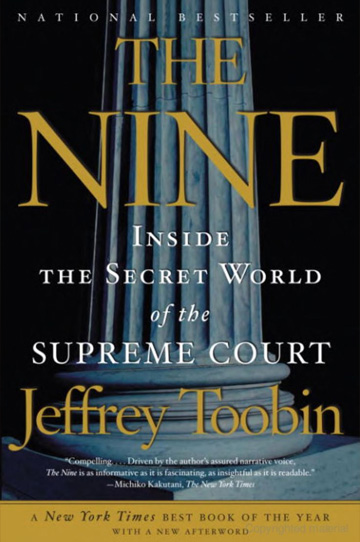
‘The Nine’ Offers Riveting Insider Reading on Supreme Court
September 7, 2007 | San Francisco Chronicle
There was one thing I really wanted to learn in “The Nine,” Jeffrey Toobin’s new book about the Supreme Court, and I came away disappointed: Why did William Rehnquist start wearing those stripes? One day in 1995, the then-chief justice emerged from behind the world’s most imposing curtain and quietly sat down to court with four gold stripes on each sleeve – like an admiral, or an officer of the starship Enterprise. It was as though Barry Bonds had walked up to the plate wearing a cape. “We thought it was a joke,” Sandra Day O’Connor said. But she and her colleagues were afraid to ask about the robe. By God, when I’m made chief, mine will feature a swooping pterodactyl.
Supreme Court tell-alls are great. Scott Armstrong and Bob Woodward‘s 1979 “The Brethren” was of course the lodestar, based on secret interviews with a disgruntled Potter Stewart, who thought Warren Burger was a lousy chief justice and leaked it in spectacular fashion. But “The Brethren” was also unsatisfying: Like a glossy tabloid full of secrets, it made one feel a little dirty for reading it. Since then, more substantive accounts have emerged that marry backstage goods with real analysis. Edward Lazarus wrote a terrific book called “Closed Chambers” after finishing his clerkship at the court. Linda Greenhouse, a reporter, used Harry Blackmun‘s unbelievably comprehensive notes (think, “For breakfast today I decided to forgo the usual half-grapefruit for a Bosc pear, and what a delight!”) to craft an engrossing and smart demi-biography that nicely summed up the Burger years.
“The Nine” makes some sharp observations about general trends on the court, but, as a whole, reads as “The Brethren” for our times: We pay for the dish; the dish is good. Herewith, some of the juiciest tidbits.
After Rehnquist died, Dick Cheney pressed for hunting buddy Antonin Scalia to be named chief justice. Clarence Thomas uses a three-tiered screening process in his law clerk hiring to make sure only the most conservative candidates get an interview. (One of his gatekeepers is former clerk and present UC Berkeley law Professor John Yoo, who wrote much of the Bush administration’s torture policy.) Ruth Bader Ginsburg circulated a particularly nasty dissent in Bush vs. Gore, and Scalia sent her a sealed, eyes-only memo accusing her of “Al Sharpton tactics.” David Souter thought seriously about leaving the court after that decision was released in 2000. Stephen Breyer is a really loud talker, even when discussing official business in the court’s public cafeteria.
Some of the details are particularly revealing. O’Connor, the swing justice who retired in 2006, was uncharacteristically indecisive when assigned to write Grutter vs. Bollinger, the University of Michigan affirmative action case, wringing her hands and making false starts. Toobin plausibly argues that O’Connor, who prizes moderation, could not find the center; she either had to uphold the Michigan law school’s policy or strike it down. But Toobin goes too far when he suggests that by the time of her retirement, O’Connor had moved further to the left than Breyer, and oversimplifies for dramatic effect by identifying a pre-Bush vs. Gore Anthony Kennedy (a Rockefeller Republican) and a post-Bush vs. Gore Kennedy (a squishy liberal).
On substance, Toobin is definitely open to challenge when he suggests that the Rehnquist court’s vaunted “federalism revolution” is officially over and amounted to mere sparklers and bottle rockets. The court chipped away at the areas in which Congress can legislate and individuals can sue the states; these precedents may not be sexy but they cut off entire lines of (usually) progressive legislation and litigation, and their presence will be felt for years to come. Given the appointment of John Roberts and Samuel Alito – both strong states’ rights men – to the court, it seems like the federalism revolution might be just beginning.
“The Nine” contains fascinating accounts of the nominations of Roberts and Alito to replace Rehnquist and O’Connor, but otherwise offers little inside information from about 2003 onward. There’s nothing new about the Guantanamo cases, life at the Roberts court, or the decision that has had the single greatest impact on the federal courts in years: United States vs. Booker, in which the court held that the federal sentencing guidelines can no longer be binding. But the section on President Clinton’s two Supreme Court appointments – Ginsburg and Breyer – and the material on the 1990s and early 2000s generally is packed with insider detail and makes for riveting reading.
Toobin got his information by making connections, and he may lose an important one with this book. Anthony Kennedy, the court’s new swing justice, is butchered for “purple prose,” for viewing himself as a “figure of drama and wisdom” and for “high flown, sometimes rather meaningless rhetoric.” Woof. Who comes off looking best? John Paul Stevens: “Dignified, clear-headed” and blessed with “insistent eloquence.”